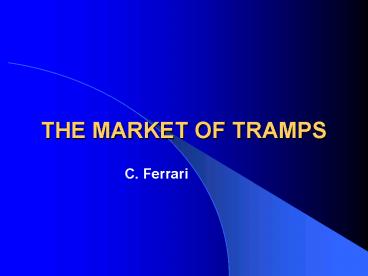THE MARKET OF TRAMPS PowerPoint PPT Presentation
1 / 21
Title: THE MARKET OF TRAMPS
1
THE MARKET OF TRAMPS
- C. Ferrari
2
The markets of maritime transport
3
Which goods are transported by sea?
Raw material oil, iron, coal Agricultural
grain, sugar, refrigerates Industrial material
rubber, forest, concrete, textiles, chemical
products Manufactured products plants,
machinery, cars, appliances, consumption
goods Industries Energy steel/metal 70 ca.
4
World seaborne trade (million tons)
Source Fearnleys, Review 2001
5
World seaborne trade (billion ton-miles)
Source Fearnleys, Review 2001
6
World seaborne trade (average miles per ton)
Source Fearnleys, Review 2001
7
Quantities and transport service
Parcel Size Distribution (PSD)
Whole ships Bulk c.
Demand (tramps)
Big quantities
Parts of ships General c.
Smaller quantities
Liners
- Many goods are partly transported bulk and
partly general - Half 90 2/3 bulk e 1/3 general
- differences
Unitization
8
Transport supply in maritime transport bulk vs.
line
Differences in management Bulk different
forms of availability of the ship for the
shipper ownership l.t., s.t. chartering spot
Liner much more complex (overhead, holds,
timetables, routes, etc.) higher fixed costs
agreement to limit competition (conferences, then
strategic alliances)
9
LINER SHIPPING (1)
TRAMP SHIPPING - CHARTERED VESSELS (1)
- fixed departures to fixed regions (goods follow
vessel) - fixed freight rates conditions (liner terms)
- specialization
- container vessels
- general cargo vessels
- ro/ro vessels
- multi-purpose vessels
- expensive vessels owing to specialization
- information processing is expensive
- goods acquisition in own hands
- gigantic investments
- shipping companies co-operate - creation of POOLS
and CONSORTIA - shipping companies involved - now FINANCIAL GROUPS
- vessel follows the goods
- freight to be discussed and depends on market
conditions (supply demand) - specialized vessels for a cer-tain type of goods
are used between regions where there is a demand
for vessel space - transport of
- bulk goods
- cereals derivatives
- coal
- ores
- gases
- frozen products
- oil
- cars
- wood
10
TRAMP SHIPPING - CHARTERED VESSELS (2)
LINER SHIPPING (2)
- owner of goods determines UNLOADING PORT
- VOYAGE CHARTER for one single voyage
- TIME CHARTER for a certain period
- BARE BOAT CHARTER for longer periods
- TECHNICAL EVOLUTION
- scale increase 300 to 500,000 t
- reasons
- demand
- long distances, such as Suez ...
- in the ports need for specialized terminals
- liner conferences formal / informal
- freight tariffs
- number of sailings
- working conditions
- why necessary ?
- reduction of freight costs
- protection of investments
- freight war
- ADVANTAGES/DISADVANTAGES
OUTSIDERS INTERMODAL TRANSPORT DOOR-TO-DOOR
SERVICE
DISTRIBUTION TERMINALS
11
Maritime transport supply
- Bulk
- liquid
- dry
- combined
- Differences in
- Hull
- Hold
- Handling
- Conditioning
- General
- loose
- container
- Roro
- refrig
12
Rates fluctuations
Source Fearnleys, Review 2001
13
Rates fluctuations
- Tramp market shows much fluctuations in respect
of container shipping because the latter is
predominantly a time charter market - Tanker market is more volatile than the bulk
market - The market for bigger ships is much more volatile
than the market for smaller ships - Individual ships when solely working in the
spot market may experience a more pronounced
rate development
14
Factors influencing the rate movements
- Shape of the supply curve (S)
- Shape of the demand curve (D)
- Changes in supply
- Changes in demand
15
Shape of the supply curve
- Shipping costs may be divided in
- Capital costs (depreciation, interests)
- Voyage costs (bunker, port/cargo handling)
- Operating costs (crew wages, insurance, repair
maintenance, classification) - Voyage and operating costs are variable costs.
- If a ship does not operate, shipowner bears
lay-up costs (crew to look for the vessel, port
fees, etc.) - Shipowners sign a charter rate if the earnings
equals - E O V L
- Since most shipowners have the same costs they
all start to offer their ships at the same
minimum rate
16
Shape of the demand curve
Demand for shipping services is rather
inelastic. It is so because demand for shipping
is a derived demand, so in the short term even a
great increase in shipping rates have not effects
on the production functions of firms. In the long
run, firms may consider alternative means of
transport, but sea transport is much less
expansive than overland means of transport (road,
rail).
17
Supply and Demand in tramp shipping
Freight rate
S
D4
D3
p4
D2
D1
p3
p1
Ton-miles
18
Changes in supply
- In the short term supply is usually considered
fixed (but it is not strictly so). - In the medium-long term, supply is influenced by
- Actual fleet, its productivity (speed, load
factor, port times) and changes of productivity - Increases of fleet by newbuildings (with a time
lag) and by hybrid ships switching from other
markets - Decreases of fleet by scrapping of ships, by
blocked ships (port congestion, maintenance), by
hybrid ships leaving the market - Sentiment of shipowners (which may have
preferred time charters, so limiting supply for
voyage charters pushing charter rates
significantly up)
19
Changes in demand
- There are a lot of factor influencing demand.
Some factors act either to counterbalance each
other (so the effect on the charter market is
null), others add so that demand is strongly
pushed up. - Economic world development
- Political and social factors (wars and strikes)
- Weather or natural disasters (drought, flood,
earthquake)
20
Prices in maritime transport markets
21
Prices over time

